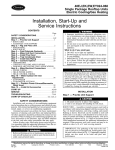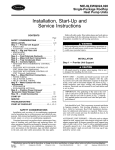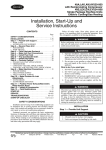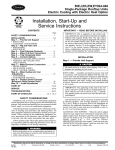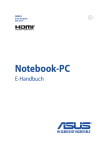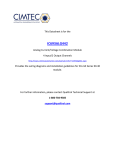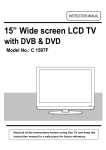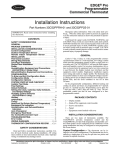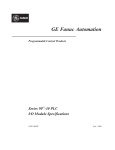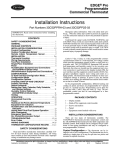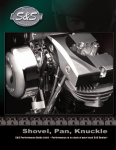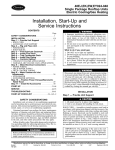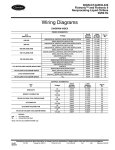Download Carrier EWQ024 Specifications
Transcript
48/50EJ,EK,EW,EY024-068 50EJQ,EWQ024,028 Gas Heating/Electric Cooling Electric Cooling and Heat Pump Units (50/60 Hz) Wiring Diagrams NOTE: This literature applies to units produced after 11/3/96 (software version 2.0 or greater) DIAGRAM INDEX UNIT LABEL DIAGRAM Unit Voltage ALL 48EJ,EW024-034 208/230-3-60 460-3-60 575-3-60 ALL 48EK,EY024-034 208/230-3-60 460-3-60 575-3-60 ALL 50EJ,EW024-034 208/230-3-60 460-3-60 575-3-60 380-3-60 400-3-50 ALL 50EK,EY024-034 208/230-3-60 460-3-60 575-3-60 380-3-60 400-3-50 ALL 48EJ,EW038-048 208/230-3-60 460-3-60 575-3-60 ALL 48EJ,EY038-048 208/230-3-60 460-3-60 575-3-60 Label Diagram Type Component Arrangement 120-V Control Circuit 24-V Control Circuit Power Schematic Power Schematic Power Schematic Component Arrangement 120-V Control Circuit 24-V Control Circuit Power Schematic Power Schematic Power Schematic Component Arrangement 120-V Control Circuit 24-V Control Circuit Power Schematic Power Schematic Power Schematic Power Schematic Power Schematic Component Arrangement 120-V Control Circuit 24-V Control Circuit Power Schematic Power Schematic Power Schematic Power Schematic Power Schematic Component Arrangement 120-V Control Circuit 24-V Control Circuit Power Schematic Power Schematic Power Schematic Component Arrangement 120-V Control Circuit 24-V Control Circuit Power Schematic Power Schematic Power Schematic Serial Number Effective 3497F 1597F 3497F 2996F 2996F 2996F 3497F 1597F 2698F 2996F 2996F 2996F 3497F 1597F 1897F 2996F 2996F 2996F 2996F 2996F 3497F 1597F 2698F 2996F 2996F 2996F 2996F 2996F 1198F 1597F 3497F 1597F 1597F 2996F 1198F 1597F 2698F 1597F 1597F 2996F Label Diagram Figure No. 48EJ500730 48EJ501531 48EJ500387 48EJ500727 48EJ500727 48EJ500907 48EJ500730 48EJ501532 48EJ500729 48EJ500727 48EJ500727 48EJ500907 48EJ500730 48EJ501531 48EJ500900 48EJ500727 48EJ500727 48EJ500907 48EJ500908 48EJ500908 48EJ500730 48EJ501532 48EJ500901 48EJ500727 48EJ500727 48EJ500907 48EJ500908 48EJ500908 48EJ501527 48EJ501531 48EJ500387 48EJ501533 48EJ501533 48EJ500909 48EJ501527 48EJ501532 48EJ500729 48EJ501533 48EJ501533 48EJ500909 1 2 3 4 4 5 1 6 7 4 4 5 1 2 8 4 4 5 9 9 1 6 10 4 4 5 9 9 11 2 3 12 12 13 11 6 7 12 12 13 Manufacturer reserves the right to discontinue, or change at any time, specifications or designs without notice and without incurring obligations. Book 1 1 1 PC 111 Catalog No. 564-826 Printed in U.S.A. Form 48/50E-2W Pg 1 9-98 Replaces: 48/50E-1W Tab 1a 1b 5a DIAGRAM INDEX (cont) UNIT LABEL DIAGRAM Unit Voltage ALL 50EJ,EW038-048 208/230-3-60 460-3-60 575-3-60 380-3-60 400-3-50 ALL 50EJ,EY038-048 20/230-3-60 460-3-60 575-3-60 380-3-60 400-3-50 ALL 48EJ,EW054-068 208/230-3-60 460-3-60 575-3-60 ALL 48EK,EY054-068 208/230-3-60 460-3-60 575-3-60 ALL 50EJ,EW054-068 208/230-3-60 460-3-60 575-3-60 380-3-60 400-3-50 ALL 50EK,EY054-068 208/230-3-60 460-3-60 575-3-60 380-3-60 400-3-50 ALL 50EJQ,EWQ024,028 208/230-3-60 460-3-60 Label Diagram Type Component Arrangement 120-V Control Circuit 24-V Control Circuit Power Schematic Power Schematic Power Schematic Power Schematic Power Schematic Component Arrangement 120-V Control Circuit 24-V Control Circuit Power Schematic Power Schematic Power Schematic Power Schematic Power Schematic Component Arrangement 120-V Control Circuit 24-V Control Circuit Power Schematic Power Schematic Power Schematic Component Arrangement 120-V Control Circuit 24-V Control Circuit Power Schematic Power Schematic Power Schematic Component Arrangement 120-V Control Circuit 24-V Control Circuit Power Schematic Power Schematic Power Schematic Power Schematic Power Schematic Component Arrangement 120-V Control Circuit 24-V Control Circuit Power Schematic Power Schematic Power Schematic Power Schematic Power Schematic Component Arrangement 120-V Control Circuit 24-V Control Circuit Power Schematic Power Schematic 2 Serial Number Effective 1198F 1597F 1897F 1597F 1597F 2996F 2996F 2996F 1198F 1597F 2698F 1597F 1597F 2996F 2996F 2996F 0898F 4297F 0898F 4297F 4297F 4297F 0898F 4297F 2698F 4297F 4297F 4297F 0898F 4297F 0898F 4297F 4297F 4297F 4297F 4297F 0898F 4297F 2698F 4297F 4297F 4297F 4297F 4297F 4297F 1597F 2997F 2996F 2996F Label Diagram Figure No. 48EJ501527 48EJ501531 48EJ500900 48EJ501533 48EJ501533 48EJ500909 48EJ600910 48EJ500910 48EJ501527 48EJ501532 48EJ500901 48EJ501533 48EJ501533 48EJ500909 48EJ500910 48EJ500910 48EJ501662 48EJ501669 48EJ501661 48EJ501659 48EJ500076 48EJ501663 48EJ501662 48EJ501664 48EJ501665 48EJ501659 48EJ500076 48EJ501663 48EJ501662 48EJ501669 48EJ501666 48EJ501659 48EJ500076 48EJ501663 48EJ501667 48EJ501667 48EJ501662 48EJ501664 48EJ501668 48EJ501659 48EJ500076 48EJ501663 48EJ501667 48EJ501667 48EJ500730 48EJ501531 48EJ501040 48EJ500727 48EJ500727 11 2 8 12 12 13 14 14 11 6 10 12 12 13 14 14 15 16 17 18 19 20 15 21 22 18 19 20 15 21 23 18 19 20 24 24 15 21 25 18 19 20 24 24 1 2 26 4 4 DIAGRAM INDEX (cont) ACCESSORIES Item Power Exhaust (Constant Volume and Modulating) Base Control Board Expansion Board Electric Heat MotormasterT III Head Pressure Control Device Remote Control Panel Heat Interlock Relay Field-Control Remote Start/Stop Enthalpy Control LID-2B Interface Space Temperature Averaging T-55 Space Temperature Sensor T-56 Space Temperature Sensor Service Tool Wiring Supply-Air Temperature Reset Smoke Detector VFD Control Figure No. 27,28* 29 30,31 32 33-37 38 39 40 41 42 43 44 45,46 47 48 49 50 *For 024-048 units power exhaust is shown in the unit wiring diagrams. Refer to the power and control wiring diagrams for wiring information. For 054-068 units, the power exhaust is shown in Fig. 27 and 28. expanded I/O points; perform Fire/Smoke control (power exhaust required); if in Occupied mode, perform IAQ control and monitor the fan, filter, demand limit, and fieldapplied status (with accessories). If thermostats are used to energize the G input, the control module will turn on the indoor fan without delay and open the economizer dampers to minimum position. If thermostats are used to deenergize the G input, the control module will turn off the indoor fan without delay and close the economizer dampers. When cooling, G must be energized before cooling can operate. The control module determines if outdoor conditions are suitable for economizer cooling using the standard outdoor air thermistor. For the economizer to function for outside air cooling: the enthalpy must be below the enthalpy set point; the outdoor-air temperature must be equal to or less than the High Outdoor Air Temperature Lockout (default is 65 F); the SAT (supply-air temperature) thermistor must not be in alarm; and the outdoor air reading is available. When these conditions are satisfied, the control module will use economizer as the first stage of cooling. When Y1 input is energized, the economizer will be modulated to maintain SAT at the defined set point. (The default is 55 F.) When SAT is above the set point, the economizer will be 100% open. When SAT is below the set point, the economizer will modulate between minimum and 100% open position. When Y2 is energized, the control module will turn on compressor no. 1 and continue to modulate the economizer as described above. If the Y2 remains energized and the SAT reading remains above the set point for 15 minutes, compressor no. 2 will turn on. If Y2 is deenergized at any time, only the last stage of compression that was energized will be turned off. If outdoor conditions are not suitable for economizer cooling, the economizer will go to minimum position and cycle compressors no. 1 and 2 based on demand from Y1 and Y2 respectively. The compressors will be locked out when the SAT temperature is too low (less than 40 F for compressor no. 1 and less than 45 F for compressor no. 2). After a compressor is locked out, it can restart after normal Time Guardt period. The Time Guard function maintains a minimum off time of 5 minutes, a minimum on time of 10 seconds, and a minimum delay before starting the second compressor of 10 seconds. 48/50EJ,EK,EW,EY UNITS NOTE: Unit is shipped with default values that can be changed through CCN software or using an accessory LID-2B. Cooling, Constant Volume (CV) Units — On power up, the control module will activate the initialization software. The initialization software reads each DIP switch to determine the unit configuration. The initialization sequence: clears all alarms and alerts; re-maps the input/ output database for CV operation; sets maximum heat stages to 2; and sets maximum cool stages to 3. The control module reads DIP switch no. 3 and determines if the unit will use expansion mode operation. The TSTAT function performs a thermostat based control by monitoring Y1, Y2, W1, W2, and G inputs. These functions control stages: cool1, cool2, heat1, heat2, and the indoor fan, respectively. If the TSTAT function is not selected, the control module determines the occupancy state based on the system time schedules with a field-supplied sensor installed, or with remote occupied/unoccupied input. If Temperature Compensated Start is active, the unit will be controlled as in the Occupied mode. Occupied or unoccupied comfort set points must be selected. The control module will set appropriate operating mode and fan control. The control module will turn on indoor fan if in Occupied mode or if the unit is in Unoccupied mode and the space temperature is outside of the unoccupied comfort set points (Unoccupied Heat or Unoccupied Cool). The control module will then monitor space temperature against comfort set points and control heating or cooling stages as required. If the system is in the Occupied mode, the economizer will operate as required. If the system is in Unoccupied mode, the system will perform nighttime free cool and IAQ (indoor air quality) pre-occupancy purge as required (when functions are enabled via software). Whenever the DX (direct expansion) cooling is requested, the outdoor fan will operate. The control module will operate economizer, run diagnostics to monitor alarms/alerts at all times, and respond to CCN communications to perform any configured network POC (product outboard control) functions such as time/ outdoor-air temperature broadcast and global occupancy broadcast. When the optional expansion I/O board is employed, it will: perform a periodic scan and maintain a database of 3 stage heat, both induced-draft motors operate, both gas valves are energized, and both IGC boards initiate spark. All of the gas heating control is performed through the IGC boards (located in the heating section). The base module board serves only to initiate and terminate heating operation. The base module board is powered by 24 vac. When the thermostat or room sensor calls for heating, power is sent from the base module board to W on each of the IGC boards. An LED on the IGC board will be on during normal operation. A check is made to ensure that the rollout switches and limit switches are closed and the induced-draft motors are not running. The induced-draft motors are then energized, and when speed is proven with the hall effect sensor on the motor, the ignition activation period begins. The burners will ignite within 5 seconds. When ignition occurs the IGC board will continue to monitor the condition of the rollout and limit switches, the hall effect sensor, as well as the flame sensor. If the unit is controlled through a room thermostat set for fan auto., 45 seconds after ignition occurs, the indoor-fan motor will be energized and the outdoor-air dampers will open to their minimum position. If for some reason the overtemperature limit opens prior to the start of the indoor fan blower, on the next attempt, the 45-second delay will be shortened to 5 seconds less than the time from initiation of heat to when the limit tripped. Gas will not be interrupted to the burners and heating will continue. Once modified, the fan on delay will not change back to 45 seconds unless power is reset to the control. If the unit is controlled through a room sensor, the indoor fan will be operating in the Occupied mode and the outdoor-air dampers will be in the minimum position. If the unit is controlled with a room sensor in the Unoccupied mode, the indoor fan will be energized through the IGC board with a 45-second delay and the outside-air dampers will move to the IAQ (indoor air quality) position (generally closed in the Unoccupied mode). If IAQ is not enabled, dampers will move to the minimum position. When additional heat is required, W2 closes and initiates power to the second stage of the main gas valves. When the thermostat is satisfied, W1 and W2 open and the gas valves close interrupting the flow of gas to the main burners. If the call for W1 lasted less than 1 minute, the heating cycle will not terminate until 1 minute after W1 became active. If the unit is controlled through a room thermostat set for fan auto., the indoor-fan motor will continue to operate for an additional 45 seconds then stop and the outdoor-air dampers will close. If the overtemperature limit opens after the indoor motor is stopped within 10 minutes of W1 becoming inactive, on the next cycle the time will be extended by 15 seconds. The maximum delay is 3 minutes. Once modified, the fan off delay will not change back to 45 seconds unless power is reset to the control. If the unit is controlled through a room sensor, the indoor fan will be operating in the Occupied mode and turned off after 45 seconds in the Unoccupied mode. 50 SERIES UNITS — The control module is powered by 24 vac. If the unit is controlled with a room sensor, the fan will run continuously in the Occupied mode, with the outsideair damper in the minimum position. If the unit is controlled through a room thermostat (with FAN set to AUTO), upon a call for heat the first stage of heat is energized, the indoorfan motor will turn on, and the outdoor-air damper will move to the minimum position. Upon a call for additional heat (if the unit is equipped with a two-stage heater), the second stage of heat is energized. When the call for heat is satisfied, the heaters will deenergize. The indoor-fan motor will also deenergize (unless controlled by a room sensor) and the outdoorair damper will move to the closed position. When heating, the heat stages respond to the demand from W1 and W2 of the thermostat input. Heating and cooling will be mutually locked out on demand on a first call basis. The heating and the cooling functions cannot operate simultaneously. Cooling, Variable Air Volume (VAV) Units — On power up, the control module will activate the initialization software. The initialization software reads each DIP switch to determine the unit configuration. The initialization sequence: clears all alarms and alerts; re-maps the input/ output database for VAV operation; sets maximum heat stages to 1; and sets maximum cool stages to 6. The control module reads DIP switch no. 3 and determines if the unit will use expansion mode operation. Power up takes a random time of 1 to 63 seconds plus 5 minutes the first time power is sent to the control board after a power outage. The control module will determine if an interface (linkage) is active and if the unit will operate in a Digital Air Volume (DAV) mode. In a DAV system, the room terminals are equipped with microprocessor controls that give commands to the base unit module. If a linkage is active, the control module will replace local comfort set points, space and return air temperatures, and occupancy status with the linkage data supplied. The control module will determine occupancy status from Time Schedules (if programmed), Remote Occupied/ Unoccupied input, global occupancy schedules, or DAV. If temperature compensated start is active, the unit will be controlled as in the Occupied mode. Temperature compensated start is a period of time calculated to bring the unit on while in Unoccupied mode to reach the occupied set point when occupancy occurs. The control module will set the appropriate operating mode and fan control. The control module will turn on the variable frequency drive (VFD) if Occupied mode is evident. If in Unoccupied mode and a valid return-air temperature reading is available (either from a sensor or DAV), the control module will monitor return-air temperature against unoccupied heat and cool set points. The control module will start the VFD whenever return-air temperature is outside of the set points (Unoccupied Heat or Unoccupied Cool). The VFD may also be started by nighttime thermostat via remote Occupied/Unoccupied input or by a temperature compensated start algorithm. When the VFD is running in a normal mode, the control module will start heating or cooling as required to maintain supply-air temperature at the supply air set point plus the reset (when enabled). The reset value is determined by SAT (supply-air temperature) reset and/or space temperature reset algorithms. The space temperature reset (requiring a space temperature sensor) is only available when enabled through software. When cooling, the control module will energize the power exhaust enable output to the external power exhaust controller (when power exhaust is used). The control module will run continuous diagnostics for alarms/alerts; respond to CCN (Carrier Comfort Network) communications; perform any configured network POC (Product Outboard Control) functions such as time/outdoor air temperature broadcast and global broadcast; and perform Fire/ Smoke control. Heating, Constant Volume (CV) Units 48 SERIES UNITS — The gas heat units incorporate 2 separate systems to provide gas heat. Each system incorporates its own induced-draft motor, Integrated Gas Control (IGC) board, 2 stage gas valve, manifold, etc. The systems are operated in parallel; for example, when there is a call for first 4 IAQ (indoor air quality) unoccupied position (generally set to zero in the Unoccupied mode). The duct pressure sensor will signal to the variable frequency drive to operate at full speed. When the call for heat is satisfied, the heaters will deenergize. NOTE: The HIR is not needed in a DAV system. If the unit is in the Unoccupied mode, the indoor-fan motor will deenergize and the outdoor-air damper will move to the closed position (if open). If the unit is controlled with a room sensor the fan will not run in the Unoccupied mode. Upon a call for heat, the first stage of heat is energized, the indoor-fan motor will turn on, and the outdoor air damper will move to the Unoccupied IAQ (indoor air quality) position (generally set to zero in the Unoccupied mode). The IAQ feature is enabled through system software. Upon a call for additional heat (if the unit is equipped with a two-stage heater), the second stage of heat is energized. When the call for heat is satisfied, the heaters and indoor-fan motor will deenergize and the outdoor-air damper will move to the closed position (if open). Morning Warm-Up (VAV Only with PC Accessed/ CCN Operation) — Morning warm-up occurs when the Heating, Variable Air Volume (VAV) Units control module has been programmed to turn on heat, prior to the Occupied mode, to be ready for the occupancy. Morning warm-up is a condition in VAV systems that occurs when the Temperature Compensated Start algorithm calculates a biased occupied start time and the unit has a demand for heating. The warm-up will continue into the occupied period as long as there is a need for heat. During warm-up, the unit can continue heating into the occupied period, even if occupied heating is disabled. When the heating demand is satisfied, the warm-up condition will terminate. To increase or decrease the heating demand, use the network access software to change the occupied heating set point. NOTE: To utilize morning warm-up mode, the unit occupancy schedule must be accessed via Service Tool, ComfortWorks™, or Building Supervisor software or an accessory LID-2B. For current software (version 3.0 or later), the Low Temperature Minimum Damper Position Override (LOWMDP) has a 0 to 100% limit, with a default of 100%. Think of the LOWMDP as a second minimum damper position. This LOWMDP limit change requires access to the unit software with a computer equipped with Building Supervisor, Service Tool, or ComfortWorks™ Software. When the LOWMDP is in effect the outdoor dampers will remain at the LOWMDP position (typically set to 0% closed) during heating, even in the Occupied period. For the LOWMDP to be in effect the LOWMDP must be less than the minimum damper position (MDP). For VAV applications the RAT (return-air temperature) must be less than the OHSP (occupied heat set point) minus 2° F. Table 1 summarizes the operational requirements and controlling factors for occupied heat and morning warm-up. 48 SERIES UNITS — All of the gas heating control is performed through the integrated gas control (IGC) board. The base module board serves only to initiate and terminate heating operation. NOTE: The unit is factory-configured for disabled occupied heating. Dual In-line Package (DIP) switch 5 is used to enable occupied heating (DIP switch 5 set to OPEN). Variable Air Volume (VAV) occupied heat is controlled by return-air temperature (RAT) using a 5k thermistor located just below the outdoor air dampers. A VAV unit without a space temperature sensor is also controlled by RAT. A VAV unit with a space temperature sensor has unoccupied heat controlled by space temperature (SPT). The base module board is powered by 24 vac. When there is a call for heating (either Morning Warm-Up, Unoccupied, or Occupied modes), power is sent from the base module board to W on each of the IGC boards and W2 of the main gas valve. A field-supplied heat interlock relay signals for the air terminals to open fully. The heat interlock relay is not required on DAV systems. In the Occupied mode the indoorfan motor will be operating and the outdoor-air dampers will be in the minimum position. In the Unoccupied mode the indoor-fan motor will be off, but will energize 45 seconds after the call for heat and the outdoor-air dampers will move to the IAQ (indoor air quality) Unoccupied position (generally set to closed in the Unoccupied mode). The duct pressure sensor will signal to the variable frequency drive to operate at full speed since all terminals have been driven open. An LED on the IGC board will be on during normal operation. A check is made to ensure that the rollout switches and limit switches are closed and the induced-draft motors are not running. The induced-draft motors are then energized and when speed is proven with the hall effect sensor on the motor, the ignition activation period begins. The burners will ignite within 5 seconds. When ignition occurs the IGC board will continue to monitor the condition of the rollout and limit switches, the hall effect sensor, and the flame sensor. If the call for heat lasted less than 1 minute, the heating cycle will not terminate until 1 minute after heat became active. When heating is satisfied, the power will be interrupted to the IGC board and W1 and W2 of the main gas valve. If the unit is controlled through a room sensor, the indoor fan will be operating in the Occupied mode and turned off after 45 seconds in the Unoccupied mode. 50 SERIES UNITS — The control board is powered by 24 vac. When there is a call for heating (from Morning WarmUp, Unoccupied, or Occupied modes), power is sent from the control module to energize the first stage of electric heat. A field-supplied heat interlock relay signals for the air terminals to fully open. In the Occupied mode, the indoorfan motor will operate continuously and the outdoor-air dampers will be in the minimum position. In the Unoccupied mode, the indoor-fan motor will be off, but will energize upon the call for heat. The outdoor-air dampers will move to the Table 1 — Occupied Heat and Morning Warm-Up Operation Requirements and Controlling Factors SOFTWARE VERSION 3.0 and 3.1 OCCUPIED MORNING TEMPERATURE HEAT WARM-UP CONDITION ENABLED MAY START FOR HEAT VIA DURING TO START DIP Switch Smart start or RAT < OHSP no. 5 within 10 minutes LEGEND OHSP — Occupied Heat Set Point RAT — Return-Air Temperature Morning Warm-Up (VAV Only with Stand-Alone Operation) — When a unit operates in stand-alone mode, morning warm-up occurs when the unit is energized in Occupied mode and return-air temperature (RAT) is below 68 F. Warm-up will not terminate until the RAT reaches 68 F. The heat interlock relay output is energized during morning warm-up. (A field-installed 24-vac heat interlock relay is required.) The output will be energized until the morning warm-up cycle is complete. 5 Table 2 — VFD Supply-Air Pressure Set Point Space Temperature Reset Sensor (VAV Only) — An accessory space temperature sensor (T-55 or T-56 with- PRESSURE in. wg kPa 0.00 0.000 0.25 0.062 0.50 0.124 0.75 0.187 1.00 0.249 1.25 0.311 1.50 0.373 1.75 0.435 2.00 0.498 2.25 0.560 2.50 0.622 2.75 0.684 3.00 0.747 3.25 0.809 3.50 0.871 out offset) is required. Space temperature reset is used to reset the supply-air temperature set point of a VAV system higher, as the space temperature falls below the Occupied Cool set point. As the space temperature falls below the cool set point, the supply-air temperature will be reset upward as a function of the reset ratio. Reset ratio is expressed in degrees change in supply-air temperature per degree of space temperature change. A reset limit will exist which will limit the maximum number of degrees the supply-air temperature may be raised. Both the reset ratio and the reset limit are user definable. The sequence of operation is as follows: 1. The on/off status of the unit supply fan is determined. 2. If the fan is on, the sequence will check if the system is in Occupied mode. 3. If the system is in Occupied mode, the sequence will determine if the reset option is enabled. 4. If the reset option is enabled, the sequence will read the space temperature and compare it to the Occupied Cool set point. If the temperature is below the Occupied Cool set point, the algorithm will compute the reset value and compare this value against the reset limit. If it is greater than the reset limit, the sequence will use the reset limit as the reset value. NOTE: A computer equipped with Carrier network access software (ComfortWorks™, Building Supervisor, or Service Tool) or an accessory LID-2B is required to enable this function. CONTROL (mA) VFD SET POINT 4.0 4.8 5.6 6.4 7.2 8.0 8.8 9.6 10.4 11.2 12.0 12.8 13.6 14.4 15.2 0 3 6 9 12 15 18 21 24 27 30 33 36 39 42 LEGEND VFD — Variable Frequency Drive 50EJQ,EWQ UNITS NOTE: Unit is shipped with default values that can be changed through Service Tool or CCN software. Cooling — On power up, the control module will activate the initialization software. The initialization software reads DIP switch no. 1 position to determine CV operation. Next, DIP switch no. 2 is read to determine if the control is TSTAT or sensor type operation. The initialization sequence: clears all alarms and alerts; re-maps the input/ output database for CV operation; sets maximum heat stages to 2; and sets maximum cool stages to 3. The control module reads DIP switch no. 3 and determines if the unit will use expansion mode operation. The TSTAT function performs a thermostat based control by monitoring Y1, Y2, W1, W2 and G inputs. These functions control stages: cool1, cool2, heat1, heat2, and the indoor fan respectively. If the TSTAT function is not selected, the control module determines the occupancy state based on the system time schedules or with remote occupied/ unoccupied input. If Temperature Compensated Start is active, the unit will be controlled as in the Occupied mode. Occupied or unoccupied comfort set points must be selected. Use of the space temperature offset input can also be configured. The control module will set appropriate operating mode and fan control. The control module will turn on indoor fan if in Occupied mode or if the unit is in Unoccupied mode and the space temperature is outside of the unoccupied comfort set points (Unoccupied Heat or Unoccupied Cool). The control module will then monitor space temperature against comfort set points and control heating or cooling stages as required. If the system is in the Occupied mode, the economizer will operate as required. If the system is in Unoccupied mode, the system will perform nighttime free cool and IAQ (indoor air quality) pre-occupancy purge as required (when functions are enabled via software). Whenever the DX (direct expansion) cooling is requested, the outdoor fan will operate. Supply-Air Temperature Reset (VAV Only) — A field-supplied 4 to 20 mA input signal enables the supply-air temperature to be reset 0° to 20° F (0° or 11.2° C). The supplyair temperature reset option does not need to be enabled. VFD Control Via Field-Supplied 4 to 20 mA (Third Party Transducer) — To set the VFD for field-supplied 4 to 20 mA, the VFD must be powered up; however, since it is located near the indoor air fan, operation of the fan is not desirable. To disable the fan perform the following procedure: 1. Open the indoor fan circuit breaker. 2. Remove the jumper between CC and ST on the terminal strip of the VFD (see Fig. 50). 3. Move the jumper between CC and SS1 to CC and SS2 (JOG) on the terminal strip of the VFD. 4. Close the indoor fan circuit breaker. The VFD is powered, but the fan will not operate. 5. On the front of the VFD is a keypad and display which will be used to turn off the PID. To access this field, press the PRG key until the display reads J.PrG (Jump Frequency Group Parameters). Press the ARROW key until Fb.PI (Item 7, PID Set Point Control Select) is displayed. Use the UP or DOWN arrow key to adjust the setting to 0. The default value is 0. See Table 2. 6. Open the indoor fan circuit breaker. 7. Replace the jumper between CC and ST on the terminal strip of the VFD. 8. Close the indoor fan circuit breaker. The VFD is now powered and the fan will operate. 6 heat is energized, energizing heat relay (HR2) and reversing valve solenoids (RVS1 and 2). Compressor no. 1 and 2, indoor and outdoor-fan motors start, and the outdoor-air damper will move to the Unoccupied IAQ position (generally set to zero in the Unoccupied mode). The IAQ feature is enabled through system software. Upon a call for additional heat (if equipped with electric heaters), the second stage of heat is energized. When the call for heat is satisfied, the compressors, fan motors, and heaters will be deenergized and the outdoor-air damper will move to the closed position. The control module will operate economizer, run diagnostics to monitor alarms/alerts at all times, and respond to CCN communications to perform any configured network POC (product outboard control) functions such as time/ outdoor-air temperature broadcast and global occupancy broadcast. When the optional expansion I/O board is employed, it will: perform a periodic scan and maintain a database of expanded I/O points; perform Fire/Smoke control (power exhaust required); if in Occupied mode, perform IAQ control and monitor the fan, filter, demand limit, and field-applied status (with accessories). If thermostats are used to energize the G input, the control module will turn on the indoor fan without delay and open the economizer dampers to minimum position. If thermostats are used to deenergize the G input, the control module will turn off the indoor fan without delay and close the economizer dampers. When cooling, G must be energized before cooling can operate. The control module determines if outdoor conditions are suitable for economizer cooling using the standard outdoor air thermistor. For the economizer to function for outside air cooling: the enthalpy must be below the enthalpy set point; the outdoor-air temperature must be equal to or less than the High Outdoor Air Temperature Lockout (default is 65 F); the SAT (supply-air temperature) thermistor must not be in alarm; and the outdoor air reading is available. When these conditions are satisfied, the control module will use economizer as the first stage of cooling. When Y1 input is energized, the economizer will be modulated to maintain SAT at the defined set point. (The default is 55 F.) When SAT is above the set point, the economizer will be 100% open. When SAT is below the set point, the economizer will modulate between minimum and 100% open position. When Y2 is energized, the control module will turn on compressor 1 and continue to modulate the economizer as described above. If the Y2 remains energized and the SAT reading remains above the set point for 15 minutes, compressor 2 will turn on. If Y2 is deenergized at any time, only the last stage of compression that was energized will be turned off. If outdoor conditions are not suitable for economizer cooling, the economizer will go to minimum position and cycle compressors 1 and 2 based on demand from Y1 and Y2 respectively. The compressors will be locked out when the SAT temperature is too low (less than 40 F for compressor 1 and less than 45 F for compressor 2). After a compressor is locked out, it can restart after normal Time Guardt period. The Time Guard function maintains a minimum off time of 5 minutes, a minimum on time of 10 seconds, and a minimum delay before starting the second compressor of 10 seconds. Defrost Cycle — When the temperature of the outdoor coil drops below 28 F as sensed by the defrost thermostat (DFT1 or 2) and the defrost timer is at the end of a timed period (adjustable at 30 to 90 minutes) the defrost cycle will begin. The control board will deenergize the reversing valve solenoids (RVS1 and 2) and energize the electric heat. Also, the outdoor-fan motor will stop. The unit will continue to defrost until the coil temperature as measured by DFT1 and 2 reaches 65 F or the duration of defrost cycle completes a 10-minute period. During the defrost mode, if a circuit defrosts first, the RVS will oscillate between heating and cooling modes until defrost mode is complete. This will keep the head pressure on that circuit from getting too high. At the end of the defrost cycle, the electric heaters will be deenergized, reversing valve solenoids will be energized, and the outdoor fan will start. POWER EXHAUST OPERATION Power exhaust has two options (Constant Volume and Modulating) that have the following sequence of operation: The first stage of constant volume (CV) power exhaust is enabled when the indoor fan has been energized and the desired damper position for the economizer increases above the CV power exhaust set point (PES1). The default for PES1 is set at 25%. The second stage of power exhaust is enabled when the desired damper position for the economizer increases above the second CV power exhaust set point (PES2). The default for PES2 is set at 75%. Each stage is disabled when the desired damper position decreases below the respective set points. The modulating power exhaust is enabled when the indoor fan is energized and the building pressure has exceeded the individual sequencer set points. The default set points are 0.04 in. wg (9.9 Pa) (6.3 vdc) for stage 1, 0.10 in. wg (24.9 Pa) (6.8 vdc) for stage 2, 0.16 in. wg (39.8 Pa) (7.3 vdc) for stage 3, 0.23 in. wg (57.1 Pa) (7.8 vdc) for stage 4, 0.29 in. wg (72.0 Pa) (8.3 vdc) for stage 5, and 0.35 in. wg (86.9 Pa) (8.8 vdc) for stage 6 power exhaust sequencer. Each stage also requires that the building pressure is reduced until it drops below the disable set point. The default set points are 0 in. wg (0 Pa) (6.0 vdc) for stage 1, 0.060 in. wg (14.9 Pa) (6.5 vdc) for stage 2, 0.13 in. wg (32.3 Pa) (7.0 vdc) for stage 3, 0.19 in. wg (47.2 Pa) (7.4 vdc) for stage 4, 0.25 in. wg (47.5 Pa) (8.0 vdc) for stage 5, and 0.31 in. wg (62.4 Pa) (8.5 vdc) for stage 6 power exhaust sequencer. Both of these set points are changed at the specific controlling sequencer. Heating — The control module is powered by 24 vac. If the unit is controlled with a room sensor, the fan will run continuously in the Occupied mode, with the outside-air damper in the minimum position. If the unit is controlled through a room thermostat (with FAN set to AUTO), upon a call for heat the first stage heat is energized, energizing heat relay (HR2) and reversing valve solenoids (RVS1 and 2). Compressor no. 1 and 2, indoor and outdoor-fan motors start. Upon a call for additional heat (if equipped with electric heaters), the second stage of heat is energized. When the call for heat is satisfied, the compressors, fan motors, and heaters will be deenergized and the outdoor-air damper will move to the closed position. If the unit is controlled with a room sensor the fan will not run in the Unoccupied mode unless the space temperature is below the unoccupied heat set point or above the unoccupied cool set point. Upon a call for heat, the first stage of SMOKE CONTROL MODES The 48/50EJ,EK,EW,EY and 50EJQ,EWQ units with an optional expansion board perform fire and smoke control modes. The expansion board provides 4 modes which can be used to control smoke within the conditioned area. The modes of operation are fire shutdown, pressurization, evacuation, and smoke purge. See Table 3. 7 which may be changed through network access software. To work properly, the IAQ sensor high and low reference points for the sensor that is used must match the configured values. The expansion board reacts to a 4 to 20 mA signal from the IAQ sensor. The low reference (4 mA output) must be configured to the minimum IAQ sensor reading. The high reference (20 mA output) must be configured to the maximum IAQ sensor reading. The IAQ sensor can be configured to either low or high priority. The priority value can be changed by the user. The default is low. SMOKE DETECTOR A smoke detector can be used to initiate fire shutdown. This can be accomplished by a set of normally closed pilot relay contacts which will interrupt power from the 24-v transformer, secondary ‘‘B’’ terminal to the control circuit breaker (CB4). The wire that connects these two points is white and labeled ‘‘W78.’’ NOTE: On standard gas models, the indoor fan will continue to run 45 seconds after the call for heat has been terminated. If fire shutdown is initiated the fan will stop immediately. No 45-second delay will occur. The smoke detector may be mounted in the return-air duct or the supply duct. Carrier does not make recommendations as to specific smoke detector location due to liability considerations. Low Priority — When the priority is set to low, the initial control is to the IAQ set point, but the outside air damper position will change to its minimum position when the following conditions occur: • CV units with sensor — when the space temperature is greater than the occupied cooling set point plus 2° F or when the space temperature is less than the occupied heating set point minus 2° F. • VAV units and CV units with thermostat — when the supply-air temperature is less than the supply-air temperature set point minus 8° F or when the supply-air temperature is greater than the supply air temperature set point plus 5° F for 4 minutes. • When the outdoor air quality is greater than the outdoor air quality set point (ppm) IAQ CONTROL The accessory expansion board and accessory IAQ (indoor air quality) sensor are required for IAQ control. The Carrier sensors operate with a 4 to 20 mA signal. The 4 to 20 mA signal is connected to T11 (+) and T12 (−) on the expansion board for the IAQ sensor, and T13 (+) and T14 (−) on the expansion board for the OAQ (outdoor air quality) sensor. The sensor is field-mounted and wired to the expansion board installed in the unit main control box. The IAQ sensor must be powered by a field-supplied 24-v power supply (ungrounded). Do not use the unit 24-v power supply to power the sensor. Once installed, the sensor must be enabled via unit software access. The sensor is configured with default values High Priority — When the priority is set to high, the IAQ set point controls the outside air damper exclusively, with no regard to comfort conditioning. Table 3 — Smoke Control Modes DEVICE Economizer Indoor Fan/VFD Power Exhaust (all outputs) Heat Stages HIR PRESSURIZATION 100% ON OFF OFF ON SMOKE PURGE 100% ON ON OFF ON LEGEND HIR — Heat Interlock Relay VFD — Variable Frequency Drive 8 EVACUATION 100% OFF ON OFF OFF FIRE SHUTDOWN 0% OFF OFF OFF OFF I/O CHANNEL DESIGNATIONS BASE MODULE — CV TERMINAL NO. T1-2 T3-4 T5-6 T7-8 T9-10 T11-12 T13-14 T15-16 T17-25 T18-25 T19-25 T20-25 T21-25 T22-25 ASSIGNMENT TERMINAL NO. SPT (CCN) — 10KV Thermistor T23-25 STO (CCN) — 10KV Thermistor T24-25 OAT — 5KV Thermistor T26-27 SAT — 5KV Thermistor T28-29 — T30-29 SAT Reset — AI (4 to 20 mA) T31-32 — T33-32 — T34-35 Y1 or Remote Start/Stop — DI (24 vac) T36-35 Y2 — DI (24 vac) T37-38 W1 — DI (24 vac) T39-38 W2 — DI (24 vac) K1 G — DI (24 vac) K2 Compressor 1 Safety — DI (24 vac) K3 ASSIGNMENT Compressor 2 Safety — DI (24 vac) Outside Air Enthalpy — DI (24 vac) Economizer Pos. — AO (4-20 mA) Heat 1 Relay — DO (24 vac) Heat 2 Relay — DO (24 vac) CV Power Exhaust 1/Modulating Power Exhaust — DO (115 vac) CV Power Exhaust 2 — DO (115 vac) Condenser Fan — DO (115 vac) OFC2 — DO (115 vac) — — Indoor Fan Relay — DO (LV) Compr. 1 — DO (HV) Compr. 2 — DO (HV) I/O CHANNEL DESIGNATIONS BASE MODULE — VAV TERMINAL NO. T1-2 T3-4 T5-6 T7-8 T9-10 T11-12 T13-14 T15-16 T17-25 T18-25 T19-25 T20-25 T21-25 T22-25 ASSIGNMENT SPT (CCN) — 10KV Thermistor RAT — 5KV Thermistor OAT — 5KV Thermistor SAT — 5KV Thermistor — SAT Reset — AI (4 to 20 mA) — — Remote Start/Stop — DI (24 vac) — — — — Compressor 1 Safety — DI (24 vac) TERMINAL NO. T23-25 T24-25 T26-27 T28-29 T30-29 T31-32 T33-32 T34-35 T36-35 T37-38 T39-38 K1 K2 K3 ASSIGNMENT Compressor 2 Safety — DI (24 vac) Outside Air Enthalpy — DI (24 vac) Economizer Pos. — AO (4-20 mA) Heat 1 Relay − DO (24 v) Heat Interlock Relay — DO (24 v) Modulated Power Exhaust — DO (24 vac) — Condenser Fan — DO (115 vac) OFC2 — DO (115 vac) Unloader 1 — DO (115 vac) Unloader 2 — DO (115 vac) Indoor Fan Relay — DO (LV) Compr. 1 — DO (HV) Compr. 2 — DO (HV) I/O CHANNEL DESIGNATIONS EXPANSION MODULE (Field-Installed) — CV AND VAV TERMINAL NO. T1-2 T3-4 T5-6 T7-8 T9-10 T11-12 T13-14 T15-16 T17 and TB2-1 T18 and TB2-1 T19 and TB2-1 T20 and TB2-1 T21 and TB2-1 T22 and TB2-1 AI AO CCN CV DI DO HV IAQ KV LV — — — — — — — — — — ASSIGNMENT — — — — — IAQ Indoor — AI (4 to 20 mA) IAQ Outdoor — AI (4 to 20 mA) — Fan Status — DI (24 vac) Filter Status − DI (24 vac) Field Applied Status — DI (24 vac) Demand Limit — DI (24 vac) Fire — Unit Shutdown — DI (24 vac) Fire — Pressurization — DI (24 vac) LEGEND Analog Input OAT Analog Output OFC Carrier Comfort Network RAT Constant Volume SAT Direct Input SPT Direct Output STO High Voltage T Indoor Air Quality TB Kilo-Ohms VAV Low Voltage — — — — — — — — — TERMINAL NO. T23 and TB2-1 T24 and TB2-1 T26-27 T28-29 T30 and TB2-2 T31 T33 T34 T36 T37 T39 K1 K2 K3 Outdoor-Air Temperature Outdoor Fan Contactor Return-Air Temperature Supply-Air Temperature Space Temperature Space Temperature Offset Terminal Terminal Block Variable Air Volume 9 ASSIGNMENT Fire — Evacuation — DI (24 vac) Fire — Smoke Purge — DI (24 vac) — — Alarm Light Indicator — DO (24 vac) Power Exhaust Fire No. 1 — DO (115 Power Exhaust Fire No. 2 — DO (115 Power Exhaust Fire No. 3 — DO (115 Power Exhaust Fire No. 4 — DO (115 Modulating Power Exhaust No. 5 Modulating Power Exhaust No. 6 — — — vac) vac) vac) vac) NOTE: All even numbered terminals are negative (−) polarity and all odd numbered terminals are positive (+) polarity. LEGEND AHA BP BPS BR C CAP CB CC CCB CCH CCN CLG COM COMP COMPR CR CV D DFT DIP DM DP EC EQUIP FLA FPT FU GND GRD GVR HC HIR HPS — — — — — — — — — — — — — — — — — — — — — — — — — — — — — — — — — Adjustable Heat Anticipator Building Pressure Bypass Switch Burner Relay Contactor, Compressor Capacitor Circuit Breaker Cooling Compensator Control Circuit Breaker Crankcase Heater Carrier Comfort Network Cooling Communication Compressor Motor Compressor Motor Control Relay Constant Volume Diode Defrost Thermostat Dual In-Line Package Damper Motor Duct Pressure Enthalpy Control Equipment Full Load Amps Freeze Protection Thermostat Fuse Ground Ground Gas Valve Relay Heater Contactor Heat Interlock Relay High-Pressure Switch HR HS HTG I IAQ IDM IFC IFCB IFM IFR IGC — — — — — — — — — — — INC IP L LED LPS LS MGV MMSN NC NEC NO OAQ OAT OCC OD OFC OFM PEC PEM PES — — — — — — — — — — — — — — — — — — — — Heater Relay Hall Effect Sensor Heating Ignitor Indoor Air Quality Induced-Draft Motor Indoor-Fan Contactor Indoor Fan Circuit Breaker Indoor-Fan Motor Indoor-Fan Relay Intergrated Gas Unit Controller Increasing Internal Protector Light Light-Emitting Diode Low-Pressure Switch Limit Switch Main Gas Valve Motormaster Normally Closed National Electrical Code Normally Open Outdoor Air Quality Outdoor-Air Thermostat Occupied Outside Diameter Outdoor-Fan Contactor Outdoor-Fan Motor Power Exhaust Contactor Power Exhaust Motor Power Exhaust Sequencer NOTE FOR FIG. 3, 7, 8, 10, 17, 22, 23, 25, AND 26 PESC — Power Exhaust Sequencer Controller PL — Plug Assembly R — Relay RAT — Return-Air Thermistor RS — Rollout Switch RVS — Reversing Valve Solenoid SAT — Supply-Air Thermistor SIO — Serial Input/Output SPT — Space Temperature Sensor SW — Switch T — Terminal TB — Terminal Block TC — Thermostat Cooling TH — Thermostat Heating TRAN — Transformer UNOCC — Unoccupied UL — Compressor Unloader VAV — Variable Air Volume VFD — Variable Frequency Drive Terminal (Marked) Terminal (Unmarked) Terminal Block Splice Factory Wiring Field Wiring To indicate common potential only, not to represent wiring NOTES FOR FIG. 9 AND 14 1. Connect TRAN1 to H3 for 380-v and 400-v units. 2. Connect TRAN2 to orange lead for 380-v and 400-v units. 3. Circuit breaker Must Trip Amps are equal to or less than 156% FLA for CB1 and CB2. All others are 140%. 4. If any of the original wire furnished must be replaced, it must be replaced wit type 90 C wire or its equivalent. 5. Compressors and/or fan motors are thermally protected. 6. Three-phase motors are protected against primary single phasing conditions. 1. The red and violet wires are spliced together at the factory. The brown wire has a wire nut added at the factory. NOTES FOR FIG. 4 AND 12 1. Connect TRAN1 to H4 for 460-v units. Connect to H3 for 230-v. If 208/230-v units are run with a 208-v power supply, connect to H2. 2. Connect TRAN2 to black lead for 460-v units. Connect to orange lead for 230-v units. If 208/230-v units are run with a 208-v power supply, connect to red lead. 3. Circuit breaker Must Trip Amps are equal to or less than 156% FLA for CB1 and CB2. All others are 140%. 4. If any of the original wire furnished must be replaced, it must be replaced with type 90 C wire or its equivalent. 5. Compressors and/or fan motors are thermally protected. 6. Three-phase motors are protected against primary single phasing conditions. NOTES FOR FIG. 18 1. If 208/230-v units are run with a 208-v power supply, connect to H2. 2. If 208/230-v units are run with a 208-v power supply, connect to red lead. 3. Circuit breaker Must Trip Amps are equal to or less than 156% FLA for CB1 and CB2. All others are 140%. 4. If any of the original wire furnished must be replaced, it must be replaced with type 90 C wire or its equivalent. 5. Fan motors are thermally protected. 6. Three-phase motors are protected against primary single phasing conditions. NOTES FOR FIG. 5 AND 13 1. Connect TRAN1 to H4 for 575-v units. 2. Connect TRAN2 to black lead for 575-v units. 3. Circuit breaker Must Trip Amps are equal to or less than 156% FLA for CB1 and CB2. All others are 140%. 4. If any of the original wire furnished must be replaced, it must be replaced with type 90 C wire or its equivalent. 5. Compressors and/or fan motors are thermally protected. 6. Three-phase motors are protected against primary single phasing conditions. NOTES FOR FIG. 19, 20, AND 24 1. Circuit breaker Must Trip Amps are equal to or less than 156% FLA for CB1 and CB2. All others are 140%. 2. If any of the original wire furnished must be replaced, it must be replaced with type 90 C wire or its equivalent. 3. Fan motors are thermally protected. 4. Three-phase motors are protected against primary single phasing conditions. 10 FACTORY SETTINGS OF MODULATING POWER EXHAUST SEQUENCERS OFF ON OFF ON Offset DIFF Voltage Voltage Static Static Stage 1 50% 3% 6.0 6.3 0.00 0.04 (PES1) Stage 2 55% 3% 6.5 6.8 0.06 0.10 (PES2) Stage 3 60% 3% 7.0 7.3 0.12 0.16 (PES3) Stage 4 64% 3% 7.4 7.7 0.18 0.22 (PES4) 11 ERROR CODE DESCRIPTION FOR CONTROL BOARD LED Blinks 2 3 4 5 6 7 8 9 10 11 Error Mode Compressor 1 Safety Compressor 2 Safety Thermostat Failure SAT Thermistor Failure OAT Thermistor Failure SPT Thermistor Failure RAT Thermistor Failure Loss of Communications with Expansion Board Control Board Failure Expansion I/O Board Failure ERROR CODE DESCRIPTION FOR IGC CONTROL BOARD LED Blinks ON OFF 1 2 3 4 5 6 7 8 Error Mode Normal Operation Hardware Failure Fan On/Off Delay Modified Limit Switch Fault Flame Sense Fault Four Consecutive Limit Switch Faults Ignition Lockout Fault Induced Draft Motor Fault Rollout Switch Fault Internal Control Fault NOTE: When W1 is energized the burners will remain on for a minimum of 60 seconds. If more than one error mode exists they will be displayed on the LED in sequence. Setting 1 Open VAV Closed CV BASE MODULE CONTROL BOARD DIP SWITCH ASSIGNMENTS 2 3 4 5 6 VAV VAV Time GuardT Space Sensor Occupied Heat Override On Installed Enabled Expansion Field In Conjunction I/O Test CV, CV with Field Test Board On CCN or Modulated Set Minimum Sensors Power Exhaust Damper Position Used On VAV VAV No Space Occupied Heat Base Field Sensor Disabled Control Time Guard Test Board Override Off CV Off CV Only Constant Volume Thermostat Power Exhaust 7 8 Gas Heat Heat Pump Electric Heat Standard A/C Operation Fig. 1 — Component Arrangement — 48/50EJ,EK,EW,EY024-034 and 50EJQ,EWQ024,028 Units VFD SET POINTS FOR SUPPLY AIR PRESSURE Pressure Control VFD in. wg Output mA Set Point 0.00 4.00 0.0 0.25 4.80 3.0 0.50 5.60 6.0 0.75 6.40 9.0 1.00 7.20 12.0 1.25 8.00 15.0 1.50 8.80 18.0 1.75 9.60 21.0 2.00 10.40 24.0 2.25 11.20 27.0 2.50 12.00 30.0 2.75 12.80 33.0 3.00 13.60 36.0 3.25 14.40 39.0 3.50 15.20 42.0 12 Fig. 2 — Control Circuit (120-V) — 48/50EJ,EW024-048 and 50EJQ,EWQ024,028 Units 13 Fig. 3 — Control Circuit (24-V) — 48EJ,EW024-048 Units 14 TABLE A The Following Compressors Have Two Parallel Wires Run from TB1 to the Compressors Compressor Wire Voltage Model Quantity 06D-537 208/230-3-60 2 TABLE B The Following Fan Motors Have Two Parallel Wires Run from TB1 to the Fan Motors Indoor Wire Voltage Motor Quantity 20 Hp 208/230-3-60 2 Fig. 4 — Power Schematic — 48/50EJ,EK,EW,EY024-034 and 50EJQ,EWQ024,028; 208/230-3-60 and 460-3-60 Units 15 Fig. 5 — Power Schematic — 48/50EJ,EK,EW,EY024-034; 575-3-60 Units 16 Fig. 6 — Control Circuit (120-V) — 48/50EK,EY024-048 Units 17 TABLE A For Software Version 1.0 Connect Between R and Y1 For Software Version 2.0 Connect Between R and W1 Fig. 7 — Control Circuit (24-V) — 48EK,EY024-048 Units 18 TABLE A For Software Version 1.0 Connect Between R and Y1 For Software Version 2.0 Connect Between R and W1 Fig. 8 — Control Circuit (24-V) — 50EJ,EW024-048 Units 19 Fig. 9 — Power Schematic — 50EJ,EK,EW,EY024-034; 380-3-60 and 400-3-50 Units 20 TABLE A For Software Version 1.0 Connect Between R and Y1 For Software Version 2.0 Connect Between R and W1 Fig. 10 — Control Circuit (24-V) — 50EK,EY024-048 Units VFD SET POINTS FOR SUPPLY AIR PRESSURE Pressure Control VFD in. wg Output mA Set Point 0.00 4.00 0.0 0.25 4.80 3.0 0.50 5.60 6.0 0.75 6.40 9.0 1.00 7.20 12.0 1.25 8.00 15.0 1.50 8.80 18.0 1.75 9.60 21.0 2.00 10.40 24.0 2.25 11.20 27.0 2.50 12.00 30.0 2.75 12.80 33.0 3.00 13.60 36.0 3.25 14.40 39.0 3.50 15.20 42.0 21 BASE MODULE CONTROL BOARD DIP SWITCH ASSIGNMENTS (VERSION 1.0 SOFTWARE) Setting 1 2 3 4 5 6 7 8 Time GuardT Expansion Field Modulated Override On Factory CCN/ Gas Open VAV I/O Test Power Set Minimum Test Sensors Heat Board On Exhaust Damper Position On On Time Guard Base Field CV Override Off Electric Factory Closed CV Thermostat Board Test Power Set Minimum Test Heat Only Off Exhaust Damper Position Off Off ERROR CODE DESCRIPTION FOR CONTROL BOARD LED Blinks Error Mode 2 Compressor 1 Safety 3 Compressor 2 Safety 4 Thermostat Failure 5 SAT Thermistor Failure 6 OAT Thermistor Failure 7 SPT Thermistor Failure 8 RAT Thermistor Failure 9 Loss of Communications with Expansion Board 10 Control Board Failure 11 Expansion I/O Board Failure NOTE: When W1 is energized the burners will remain on for a minimum of 60 seconds. If more than one error mode exists they will be displayed on the LED in sequence. BASE MODULE CONTROL BOARD DIP SWITCH ASSIGNMENTS (VERSION 2.0 SOFTWARE) 1 2 3 4 5 6 7 8 VAV VAV Time Guard Space Sensor Occupied Heat Override On Installed Enabled Expansion Field Heat Gas In Conjunction Open VAV I/O Test Pump CV, Heat CV with Field Test Board On Operation CCN or Modulated Set Minimum Sensors Power Exhaust Damper Position Used On Setting Closed CV VAV No Space Sensor CV Thermostat Base Control Board Only Field Test Off VAV Occupied Heat Disabled CV Constant Volume Power Exhaust ERROR CODE DESCRIPTION FOR IGC CONTROL BOARD Error Mode Normal Operation Hardware Failure Fan On/Off Delay Modified Limit Switch Fault Flame Sense Fault Four Consecutive Limit Switch Faults Ignition Lockout Fault Induced Draft Motor Fault Rollout Switch Fault Internal Control Fault LED Blinks ON OFF 1 2 3 4 5 6 7 8 Time Guard Override Off Electric Heat Fig. 11 — Component Arrangement — 48/50EJ,EK,EW,EY038-048 Standard A/C Operation FACTORY SETTINGS OF MODULATING POWER EXHAUST SEQUENCERS OFF ON OFF ON Offset DIFF Voltage Voltage Static Static Stage 1 50% 3% 6.0 6.3 0.00 0.04 (PES1) Stage 2 55% 3% 6.5 6.8 0.06 0.10 (PES2) Stage 3 60% 3% 7.0 7.3 0.12 0.16 (PES3) Stage 4 64% 3% 7.4 7.7 0.18 0.22 (PES4) 22 TABLE A The Following Compressors Have Two Parallel Wires Run from TB1 to the Compressors Compressor Wire Voltage Model Quantity 06D-537 208/230-3-60 2 06E-250 208/230-3-60 2 06E-265 208/230-3-60 2 TABLE B The Following Fan Motors Have Two Parallel Wires Run from TB1 to the Fan Motors Indoor Wire Voltage Motor Quantity 20 Hp 208/230-3-60 2 25 Hp 208/230-3-60 2 30 Hp 208/230-3-60 2 Fig. 12 — Power Schematic — 48/50EJ,EK,EW,EY038-048; 208/230-3-60 and 460-3-60 Units 23 Fig. 13 — Power Schematic — 48/50EJ,EK,EW,EY038-048; 575-3-60 Units 24 Fig. 14 — Power Schematic — 50EJ,EK,EW,EY038-048; 380-3-60 and 400-3-50 Units VFD SET POINTS FOR SUPPLY AIR PRESSURE Pressure Control VFD in. wg Output mA Set Point 0.00 4.00 0.0 0.25 4.80 3.0 0.50 5.60 6.0 0.75 6.40 9.0 1.00 7.20 12.0 1.25 8.00 15.0 1.50 8.80 18.0 1.75 9.60 21.0 2.00 10.40 24.0 2.25 11.20 27.0 2.50 12.00 30.0 2.75 12.80 33.0 3.00 13.60 36.0 3.25 14.40 39.0 3.50 15.20 42.0 25 ERROR CODE DESCRIPTION FOR CONTROL BOARD LED Blinks Error Mode 2 Compressor 1 Safety 3 Compressor 2 Safety 4 Thermostat Failure 5 SAT Thermistor Failure 6 OAT Thermistor Failure 7 SPT Thermistor Failure 8 RAT Thermistor Failure 9 Loss of Communications with Expansion Board 10 Control Board Failure 11 Expansion I/O Board Failure ERROR CODE DESCRIPTION FOR IGC CONTROL BOARD Error Mode Normal Operation Hardware Failure Fan On/Off Delay Modified Limit Switch Fault Flame Sense Fault Four Consecutive Limit Switch Faults Ignition Lockout Fault Induced Draft Motor Fault Rollout Switch Fault Internal Control Fault LED Blinks ON OFF 1 2 3 4 5 6 7 8 NOTE: When W1 is energized the burners will remain on for a minimum of 60 seconds. If more than one error mode exists they will be displayed on the LED in sequence. Setting 1 Open VAV Closed CV BASE MODULE CONTROL BOARD DIP SWITCH ASSIGNMENTS 2 3 4 5 6 VAV VAV Time GuardT Space Sensor Occupied Heat Override On Installed Enabled Expansion Field In Conjunction I/O Test CV, CV with Field Test Board On CCN or Modulated Set Minimum Sensors Power Exhaust Damper Position Used On VAV VAV No Space Occupied Heat Base Field Sensor Disabled Control Time Guard Test Board Override Off CV Off CV Only Constant Volume Thermostat Power Exhaust 7 8 Gas Heat Heat Pump Operation Electric Heat Standard A/C Operation Fig. 15 — Component Arrangement — 48/50EJ,EK,EW,EY054-068 Units FACTORY SETTINGS OF MODULATING POWER EXHAUST SEQUENCERS OFF ON OFF ON Offset DIFF Voltage Voltage Static Static Stage 1 (PES1) 50% 3% 6.0 6.3 0.00 0.04 Stage 2 (PES2) 55% 3% 6.5 6.8 0.06 0.10 Stage 3 (PES3) 60% 3% 7.0 7.3 0.13 0.16 Stage 4 (PES4) 65% 3% 7.5 7.8 0.19 0.23 Stage 5 (PES5) 70% 3% 8.0 8.3 0.25 0.29 Stage 6 (PES6) 75% 3% 8.5 8.8 0.31 0.35 26 Fig. 16 — Control Circuit (120-V) — 48/50EJ,EW054-068 Units 27 Fig. 17 — Control Circuit (24-V) — 48EJ,EW054-068 Units 28 TABLE A The Following Compressors Have Two Parallel Wires Run from TB1 to the Compressors Compressor Wire Voltage Model Quantity 06E-250 208/230-3-60 2 TABLE B The Following Fan Motors Have Two Parallel Wires Run from TB1 to the Fan Motors (Not Shown on Label Diagram) Indoor Wire Voltage Motor Quantity 20 Hp 208/230-3-60 2 25 Hp 208/230-3-60 2 TABLE C The Following Fan Motors Have Two Parallel Wires Run from TB1 to IFCB (Not Shown on Label Diagram) Indoor Wire Voltage Motor Quantity 30 Hp 208/230-3-60 2 Fig. 18 — Power Schematic — 48/50EJ,EK,EW,EY054-068; 208/230-3-60 Units 29 Fig. 19 — Power Schematic — 48/50EJ,EK,EW,EY054-068; 460-3-60 Units 30 Fig. 20 — Power Schematic — 48/50EJ,EK,EW,EY054-068; 575-3-60 Units 31 Fig. 21 — Control Circuit (120-V) — 48/50EK,EY054-068 Units 32 Fig. 22 — Control Circuit (24-V) — 48EK,EY054-068 Units 33 Fig. 23 — Control Circuit (24-V) — 50EJ,EW054-068 Units 34 Fig. 24 — Power Schematic — 50EJ,EK,EW,EY054-068; 380-3-60 and 400-3-50 Units 35 Fig. 25 — Control Circuit (24-V) — 50EK,EY054-068 Units 36 Fig. 26 — Control Circuit — 50EJQ,EWQ024,028 Units 37 Fig. 27 — Power Exhaust — 48/50EJ,EK,EW,EY054-068; 208/230-3-60 and 460-3-60 Units 38 Fig. 28 — Power Exhaust — 48/50EJ,EK,EW,EY054-068; 575-3-60 Units and 50EJ,EK,EW,EY054-068; 380-3-60 and 400-3-50 Units 39 *Where X is the unit control software version number (1 or 2). Fig. 29 — Base Unit Control Board Diagram 40 Fig. 30 — Expansion Board Connections DETAIL A PRIMARY 208 V, 380 V H2 230 V, 400 V 460 V, 575 V ORG BLK/RED SECONDARY H1 BLK (COMMOM) BRN TO POSITION 2 RED 24 V H3 H4 RED Fig. 31 — Expansion Board Wiring 41 TO POSITION 1 CRHEATER124A00 (240 V, 18 kW*) CRHEATER125A00 (240 V, 36 kW†) CRHEATER126A00 (380 V, 400 V, AND 480 V, 18 kW*) CRHEATER127A00 (380 V, 400 V, AND 480 V, 36 kW†) CRHEATER128A00 (600 V, 18 kW*) CRHEATER129A00 (6000 V, 36 kW†) *Two heater assemblies total 36 kW. †Two heater assemblies total 72 kW. Fig. 32 — Accessory Heat Package Wiring Schematic 42 MMSN-1 GRA VIO GRN BLK BLK YEL YEL BLU BLU MOTOR MASTER III ACY RED BRN ORN OFC1 BLK 11 21 YEL 12 22 BLU 13 23 BLK 1 YEL 2 BLU 3 OFM1 GRN YEL Fig. 33 — MotormasterT III Device Wiring, 48/50EJ,EK,EW,EY024-034 — All Units Except 575-v Units ORN-YEL ORN YEL C1 BLK 11 21 ORN YEL 12 22 BLK 13 23 YEL X4 X3 X2 X1 YEL H1 H2 H3 H4 YEL YEL H1 H2 H3 H4 X4 X3 X2 X1 BLU BLK TRAN A1 YEL YEL BLU BLK BLU MMSN-1 GRA VIO BLK GRN MOTOR RED YEL MASTER BRN III ORN ACY BLU BLK 1 YEL 2 BLU 3 OFM1 GRN-YEL ORN-YEL TRAN 2 Fig. 34 — Motormaster III Device Wiring, 48/50EJ,EK,EW,EY024-034 — 575-3-60 Units MMR 5 9 MMSN GRA VIO OFC1 11 21 BLK 12 22 YEL 13 23 BLU MOTOR MASTER III ACY RED BLK 1 BRN YEL 2 ORN BLU 3 OFM1 GRN TB2 HR2 13 23 13 MMR 14 2 NOTE: Motormaster Relay part no. is HN61KZ024 with HY07RB030 socket. Fig. 35 — Motormaster III Device Wiring, 50EJQ,EWQ024 and 028 43 YEL GRA MMSN-1 VIO GRN BLK BLK YEL YEL BLU BLU MOTOR MASTER III ACY RED BRN ORN OFC1 BLK 11 21 BLK 1 YEL 12 22 YEL 2 BLU 13 23 BLU 3 OFM1 GRN BLK 1 YEL 2 BLU 3 YEL OFM2 GRN YEL Fig. 36 — MotormasterT III Device Wiring, 48/50EJ,EK,EW,EY038-068 — All Units Except 575-V Units ORN-YEL ORN YEL C1 BLK 11 21 YEL 12 22 BLK 13 23 ORN YEL YEL YEL YEL BLU BLK TRAN A1 X4 X3 X2 X1 H1 H2 H3 H4 H1 H2 H3 H4 X4 X3 X2 X1 YEL YEL BLU BLK BLU MMSN-1 GRA VIO BLK GRN MOTOR RED YEL MASTER BRN III ORN ACY BLU BLK 1 YEL 2 BLU 3 OFM1 GRN-YEL ORN-YEL TRAN 2 BLK 1 YEL 2 BLU 3 OFM2 GRN-YEL Fig. 37 — Motormaster III Device Wiring, 48/50EJ,EK,EW,EY038-068 — 575-3-60 Units 44 IFR 2 1 TRAN1 X2 2 CLOCK 115 VAC, 60 Hz (GROUNDED SIDE) TB2 TB6 (REMOTE PANEL) 2 12 UNOCC 1 R 3 CLOCK TB3 4 5 BPS OCC TB3 Y1 2 3 OCC 4 UNOCC 5 BASE MODULE HTG T30 6 CR1 1 CLG 7 IFR FAN 1 8 IFR 9 10 POWER 11 Fig. 38 — Remote Control Panel Wiring (Part No. 50DD-900-081) TRAN2 B CB4 3.2 AMPS COM SECONDARY 24 VOLT BASE MODULE CONTROL BOARD INDOOR FAN RELAY COM HIR (FIELD SUPPLIED) T 30 T29 T 28 Fig. 39 — Heat Interlock Relay Wiring (Part No. HN61KK040) 45 REMOTE START/STOP SWITCH R Y1 Y2 W1 W2 G C X NOTE: Switches shown in high enthalpy state. Terminals 2 and 3 close on enthalpy decrease. Fig. 41 — Wiring Connections for Solid-State Enthalpy Control (HH57AC077) CONTROL BOX Fig. 40 — Field Control Remote Start/Stop Wiring RJ 11 1 2 3 4 5 RED WHT BLK YEL BRN DEDICATED SEPARATE 24 VAC POWER SOURCE (TRANSFORMER SUPPLIED WITH LID-2B) MATING PLUG FOR BASE UNIT CONTROL MODULE COMMUNICATION PORT Fig. 42 — LID-2B Wiring 46 SPACE TEMPERATURE AVERAGING — 4 SENSOR APPLICATION SPACE TEMPERATURE AVERAGING — 9 SENSOR APPLICATION Fig. 43 — Space Temperature Averaging Wiring 47 RJ14 PLUG TB1 T2 BLACK (–) RJ14 CCN CONNECTION TO COMM PORT ON PROCESSOR MODULE E3 E1 T2 T2 T1 T1 J6 J5 J4 WHITE (GND) RED (+) J3 BASE CONTROL BOARD J2 J1 R3 E3 E2 JUMPER MUST BE BETWEEN E3 AND E2 E1 Fig. 44 — Space Temperature Sensor (T-55) Wiring TH RJ14 PLUG TB1 T1 COM T2 SW T3 T2 CCN CONNECTION TO COMM PORT ON PROCESSOR MODULE E3 E1 24VAC (+) RED (+) WHITE (GND) BLACK (–) CCN (+) CCN GND CCN (–) 24VAC (–) R3 E3 E2 E1 JUMPER MUST BE BETWEEN E3 AND E2 Fig. 45 — Space Temperature Sensor (T-56) Wiring 48 BASE CONTROL BOARD MODULE SPACE SENSOR WIRING WHEN DISTANCE BETWEEN MODULE AND SPT IS 100 FT MAXIMUM 3 COND COMM CABLE (TYP) CCN COMM BUS 100 FT MAXIMUM MODULE SPACE SENSOR WIRING WHEN DISTANCE BETWEEN MODULE AND SPT IS GREATER THAN 100 FT CCN COMM BUS Fig. 46 — Connecting the T-56 Sensor to the CCN Communications Bus CABLE USED WITH LID, ALSO CALLED STRAIGHT THROUGH CONNECTOR PHONE CABLE USED WITH SERVICE TOOL BI R G Y Y G R BI BI Y G R B W BI Y G R B W WIRING TO THE THREE PRONG CONNECTOR FROM AN RJ11 CONNECTOR NOTES: 1. To identify a standard phone cable, hold the thumb tabs towards you, and the wire colors should be opposite. Black, Red, Green, Yellow, Yellow, Green, Red, Black. 2. To identify a straight through cable, hold the thumb tabs towards you, and the wire colors should be the same. Black, Yellow, Green, Red, Blue, White, Black, Yellow, Green, Red, Blue White. OR BI R G Y Y G X 1 2 + G R BI X 3 – 1 + 2 G 3 – Fig. 47 — Service Tool Wiring 49 DEGREES F (C) RESET 0.00 (0.00) 1.25 (0.70) 2.50 (1.40) 3.75 (2.10) 5.00 (2.80) 6.25 (3.50) 7.50 (4.20) 8.75 (4.90) 10.00 (5.60) 11.25 (6.30) 12.50 (7.00) 13.75 (7.70) 15.00 (8.40) 16.25 (9.10) 17.50 (9.80) 18.75 (10.50) 20.00 (11.20) mA INPUT 4 5 6 7 8 9 10 11 12 13 14 15 16 17 18 19 20 BASE MODULE CONTROL BOARD (+) T11 4-20 mA INPUT (–) T12 FIELD SUPPLIED INPUT DEVICE NOTE: The 4 to 20 mA input is a field-supplied non-Carrier EMS (Energy Management System) device. Fig. 48 — Supply Temperature Reset Wiring NOTE: On 48E units, indoor fan will continue to run 45 seconds after control power is interrupted due to IGC board time delay. Fig. 49 — Smoke Detector Wiring (SS2) (SS3) FLA FLB FLC P24 RCH LOW FM AM PP RR IV CC + ST F R CC SS1 D P D P AD2 JUMPERS NOTE: Terminal strip is located inside the VFD at the bottom. Fig. 50 — VFD Control via Field Supplied 4 to 20 mA 50 JOG – RST CC Copyright 1998 Carrier Corporation Manufacturer reserves the right to discontinue, or change at any time, specifications or designs without notice and without incurring obligations. Book 1 1 1 PC 111 Catalog No. 564-826 Printed in U.S.A. Form 48/50E-2W Pg 52 9-98 Replaces: 48/50E-1W Tab 1a 1b 5a




















































